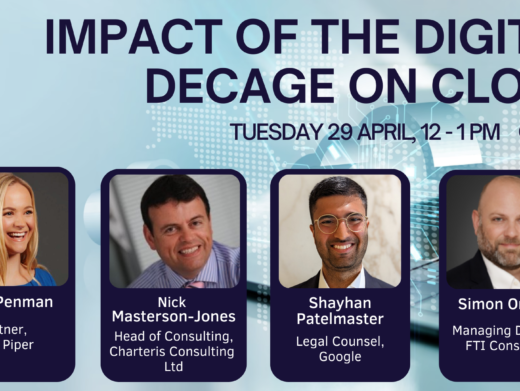The first ever breakfast seminar of the SCL Media Group, hosted by Olswang LLP, was attended by a large number of SCL members interested in the impact of the Court of Appeal’s recent decision in Tamiz v Google on the future of the law of intermediary liability and the proposed defence under the Defamation Bill.
Dominic Bray, head of the IP, Media and Technology group at K&L Gates, chaired the session and introduced the themes for the seminar. Although a very important decision on intermediary liability, Tamiz v Google perhaps poses as many questions as it answers, particularly as the key issue of the role of the hosting defences under the E-Commerce Regulations 2002 remains unaddressed.
Antony White QC, a media law specialist at Matrix Chambers who represented Google in the recent Court of Appeal decision, provided his insight into the Tamiz case and the legal landscape as regards intermediary liability following the decision.
Despite refusing Mr Tamiz’s appeal on the basis that ‘the game was not worth the candle’, the case presented the Court with an opportunity to provide further clarification on some important outstanding issues in its obiter judgment. Whilst it was not reasonable to conclude that Google could be considered a common law publisher of defamatory content on the Blogger.com platform prior to notification, the court held that it was at least arguable that a refusal or delay in removing the content post-notification could be considered to be causing or contributing to its continued publication. It was also not clear that Google would have an unassailable defence under section 1 of the Defamation Act.
Disappointingly, the Court did not address the issue of the Regulation 19 defence under the E-Commerce Regulations 2002. During the Court of Appeal hearing, the seminar learned that counsel for Mr Tamiz produced an isolated item from the travaux preparartoire from the European Commission’s enactment of the E-Commerce Directive (documents which are often difficult to source). It is possible that this made the Court of Appeal think it would be better not to explore that issue when not all of the travaux were before the court.
Ashley Hurst, a partner in the Commercial Litigation team at Olswang LLP, then spoke about the impact of the Tamiz case for the proposed intermediary defence under Clause 7 (previously Clause 5) of the Defamation Bill.
The existing defences available to intermediaries under s 1 of the Defamation Act 1996 and regs 17 and 19 of the E-Commerce Regulations 2002 provide protection in respect of defamatory content hosted on an intermediary’s platform of which it has no knowledge. These differing regimes and the generally accepted higher standard of notification required under the European legislation has led to the defence under the Defamation Act becoming increasingly overlooked.
Under the Defamation Bill, a new defence is proposed for ‘website operators’ that can show that the defamatory statement in question was posted by someone else and that it is possible to bring an action against the original author. However, many questions remain about who the process will apply to, how it will work in practice and whether it will change the default position of removing content to avoid liability.
Whilst Tamiz v Google confirms that intermediaries may be liable for defamatory content once on notice, the Court of Appeal provided no guidance as to what a claimant needs to include in a notice of complaint to demonstrate ‘unlawfulness’. Website operators may therefore be left in the same position of confusion as to the different requirements of valid notice under the parallel English and European regimes.
Whilst improvements have been made to the new clause 5/7 defence, claimants need only go through a ‘box-ticking’ exercise to submit a valid notice of complaint, even for trivial or unmeritorious claims that do not meet the basic requirements of a libel claim. A strong case can therefore be made for a procedure which allows intermediaries to obtain a declaration as to whether a claim meets the basic requirements of a libel claim or not.
Gill Phillips, Director of Editorial Legal Services at Guardian News and Media, provided insight from the perspective of the newspaper industry as to the issues and challenges facing major website operators.
The Guardian has a significant online presence, and hosts very popular comments forums which accompany the majority of its editorial content. As a major national newspaper, it has to balance important internal policy decisions regarding the overall integrity of its content with an appropriate approach to legal risk when deciding upon its moderation strategy. In practice, it therefore generally combines post-modification of comments which are flagged as unsuitable with pre-modification and blocking of certain problematic users. As such, the legal position and reasoning of the court can often differ from the practical reality.
Many of the complaints The Guardian receives relating to user-generated content would not constitute valid notice for the purposes of the relevant legislation, and The Guardian takes a robust and pragmatic view of each complaint on a case-by-case basis. In terms of the impact of the proposed clause 5/7 defence, The Guardian already faces great practical difficulties in identifying and blocking certain problematic users who can easily evade detection through technological means. In addition, the new defence will make many intermediaries, and newspapers in particular, feel uneasy about the requirement to provide the personal details of individual users without an accompanying court order. It is therefore likely that the new clause 5/7 defence will not greatly impact on The Guardian‘s practices and the existing libel defences will continue to be important.
Jack Gilbert is an Associate at Olswang LLP: www.olswang.com




